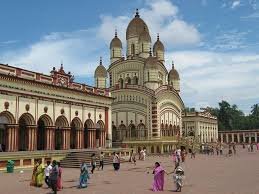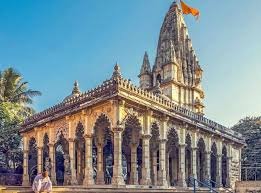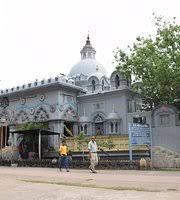Introduction
Standing majestically on the eastern banks of the Hooghly River, the Dakshineswar Kali Temple in Kolkata is one of India’s most revered spiritual landmarks. Dedicated to Goddess Bhavatarini, a powerful form of Kali, this temple is deeply intertwined with the life of Sri Ramakrishna Paramahamsa, the great 19th-century mystic and saint.
With its rich history, grand architecture, and deep spiritual significance. The temple continues to draw thousands of devotees and tourists daily. The peaceful ambiance, combined with the powerful vibrations of devotion, makes it an essential pilgrimage site.
Let’s take a journey through the history, significance, architecture, and spiritual essence of this sacred shrine.
The History Behind Dakshineswar Kali Temple
The Vision of Rani Rashmoni
According to legend, Rani Rashmoni had a vision of Goddess Kali the night before her planned pilgrimage to Varanasi. The divine mother appeared in her dream and instructed her to construct a temple on the banks of the Ganges and install her idol there. Taking this as a divine command, Rani Rashmoni purchased land in Dakshineswar and began the construction of the temple.
The temple complex was completed in 1855, and the idol of Kali was installed with grand rituals and celebrations. To ensure proper worship, Rani Rashmoni appointed Sri Ramakrishna as the temple priest, a decision that would go on to change the spiritual landscape of Bengal.
Spiritual Significance: The Influence of Sri Ramakrishna
Sri Ramakrishna and His Divine Experiences
The Dakshineswar Kali Temple is not just a place of worship—it is a site where one of the greatest saints of India, Sri Ramakrishna Paramahamsa, attained divine enlightenment.
As the temple priest, Sri Ramakrishna developed a deep connection with Goddess Kali, experiencing her divine presence in the form of living consciousness. He often fell into deep trances and samadhi (spiritual ecstasy) while worshipping her, proving that faith transcends the material world.
Architectural Marvel of Dakshineswar Kali Temple
The Dakshineswar Kali Temple is an architectural masterpiece that reflects the grandeur of Bengali temple architecture.
Key Features of the Temple’s Architecture
Nine-Spired Navaratna Temple – The main temple follows the Navaratna (nine-spired) style, a classic feature of Bengali religious architecture.
Massive Courtyard – The temple stands in a large courtyard surrounded by twelve Shiva temples, symbolizing the twelve Jyotirlingas of Lord Shiva.
Vast Temple Complex – The entire Dakshineswar temple complex covers around 25 acres, making it one of the largest temple premises in West Bengal.
Panchavati Garden – A serene garden in the temple complex where Sri Ramakrishna meditated, offering visitors a chance to experience divine peace.
Ghat on the Hooghly River – Devotees take a holy dip in the river before entering the temple, believing it purifies the soul.
The imposing structure, intricate carvings, and peaceful surroundings create a spiritual oasis that draws thousands of visitors daily.
Daily Rituals and Festivals at Dakshineswar Temple
The temple follows a strict schedule of pujas and rituals, ensuring a continuous flow of devotion.
Daily Worship Schedule
Mangala Aarti (4:00 AM) – The first ritual of the day, where the temple is awakened with prayers.
Bhog Aarti (12:00 PM) – Offerings of cooked rice, fruits, and sweets are made to the goddess.
Sandhya Aarti (6:30 PM) – The temple resonates with devotional songs and the rhythmic beats of drums.
Grand Festivals Celebrated at Dakshineswar Kali Temple
Kali Puja – The biggest festival, celebrated on Diwali night, where thousands gather to seek Goddess Kali’s blessings.
Durga Puja – A grand celebration honoring Maa Durga, bringing the temple to life with lights and devotion.
Janmashtami – Dedicated to Lord Krishna, observed with bhajans and special prayers.
Shivaratri – Devotees perform night-long vigils and prayers to Lord Shiva in the twelve Shiva temples.
Ramakrishna Jayanti – The birthday of Sri Ramakrishna, observed with religious discourses and prayers.
Why Visit Dakshineswar Kali Temple?
The Dakshineswar Kali Temple is not just a place of religious importance—it offers a transformative spiritual experience.
A Divine Spiritual Center – The temple resonates with the powerful energy of Goddess Kali, making it an ideal place for meditation.
Association with Sri Ramakrishna – Experience the place where one of India’s greatest saints had divine visions.
Architectural Beauty – The temple’s majestic nine-spired structure and its serene surroundings make it a must-visit.
Riverside Tranquility – The temple’s location on the banks of the Hooghly River offers a peaceful retreat from city life.
Cultural and Historical Significance – As one of Kolkata’s most iconic temples, it reflects the rich heritage of Bengal.
How to Reach Dakshineswar Kali Temple?
Air – The nearest airport is Netaji Subhas Chandra Bose International Airport (Kolkata Airport), 13 km away.
Rail – The closest railway station is Dakshineswar Railway Station, just 1 km away.
Metro – The Dakshineswar Metro Station connects the temple to Kolkata’s metro network.
Conclusion
The Dakshineswar Kali Temple is more than just a place of worship—it is a sanctuary of faith, devotion, and spiritual enlightenment. Whether you seek divine blessings, historical insights, or an architectural marvel, this temple has something for everyone.





